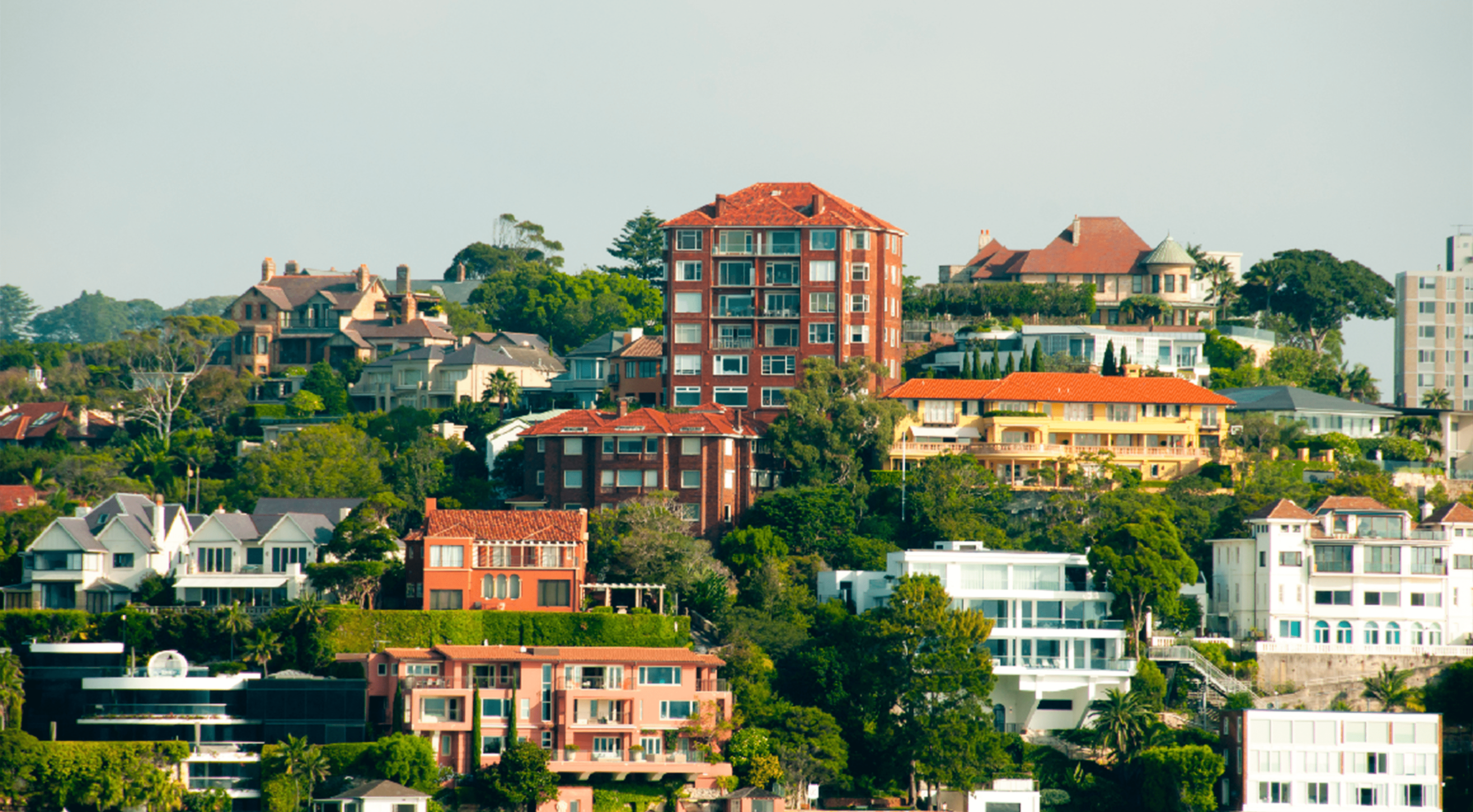Features > Property News & Insights > Housing Trends
Australia’s housing affordability declines to a three-decade low

KEY POINTS
- Housing affordability in Australia is at a 30-year low, per the REIA.
- Average mortgage repayments in Q2 2024 reached 48.1% of median family income, up 1.3% from last quarter.
- A poll by "Everybody’s Home" shows most Australians want house prices to drop to improve affordability.
New data from the Real Estate Institute of Australia (REIA) shows that housing affordability has dropped to its lowest point since the industry body began keeping records 28 years ago.
A new survey claims that more than one in two Australian voters would like to see home prices fall to improve housing affordability.
While they come at the issue from different perspectives, the social housing and rental rights organisation that commissioned the polling and the Real Estate Institute both agree that the major problem is a lack of housing stock in Australia for our population size, which suggests there’s no quick fix to the crisis.
REIA figures
The Real Estate Institute of Australia has been measuring housing affordability since 1996, but the peak body has never seen things so bad.
The group’s latest Housing Affordability Report for the June quarter of 2024 shows the average mortgage repayment now amounts to 48.1% of a median family income, 1.3% more than last quarter.
In other words, nearly half the money coming into a median family home with a mortgage in Australia is going straight back out the door in the form of repayments to the bank.
A recent chart compiled by AMP looked at the ever-increasing disconnect between Australian home prices and a “comfortable” rate of repayments at 28% of median household income - 20% below where the REIA says average mortgage repayments are now.
The housing affordability picture is mixed across the nation, with small improvements in Victoria, the Northern Territory and the ACT, but worsening in all other states.
Rental affordability also worsened over the quarter, with the proportion of income needed to meet the national median rents rising by 0.2% to 24.6%.
Again it’s a mixed picture, with rental affordability improving in NSW, Tasmania and the ACT, but declining in all other states and territories.
With the Reserve Bank of Australia maintaining the official cash rate at 4.35%, the REIA estimates average standard variable interest rates remained stable across the quarter at 8.8%, with the quarterly average three-year fixed rate also holding steady at 6.8%.
“Over the June quarter, the average loan size increased to $629,249, an increase of 3.6% over the June quarter, and 7.9% over the past 12 months,” says the Institute’s President, Leanne Pilkington.
Despite worsening affordability, high retail interest rates and bigger average loan sizes, Ms Pilkington says the total number of owner-occupier dwelling loans increased over the three months to the end of June to 83,599, marking an increase of 18.8% over the quarter and 6.9% over the past 12 months.
Ms Pilkington acknowledges schemes like the Federal government’s Housing Guarantee Scheme have "helped many Australians into home ownership, but high interest rates and inflation continue to pose significant challenges."
The Federal government program includes a number of initiatives, including the First Home Guarantee, which gives 35,000 first home buyers the ability to purchase a property to live in without having to come up with a 20% deposit to avoid banks’ lenders mortgage insurance requirements.
Everybody’s Home survey
Social housing and renter’s rights group Everybody’s Home says a new poll commissioned shows that most voters want house prices to drop in order for housing affordability to improve.
Survey company RedBridge polled 2,000 Australian voters, and Everybody’s Home says this reveals that 54% want house prices to go down over the next five years, while only 21% want prices to increase.
“Australia’s runaway home prices are so out of reach for so many voters that most want to see them come down,” says Everybody’s Home spokesperson Maiy Azize.
“It’s a tired trope that homeowners want house prices to keep rising.”
This is a direct reference to infamous comments by former Liberal Prime Minister John Howard, who famously said in 2003, “I haven't found anybody in seven and a half years shake their fist at me and say “Howard, I'm angry with you for letting the value of my house increase.”
However, if you delve into the Redbridge polling for Everybody’s Home, there’s a clearer divide between those who own houses and those who don’t.
Only 44% of people with a mortgage (presumably most were owner-occupiers) thought house prices should fall, while 28% wanted prices to keep rising.
However, 72% of renters wanted house prices to fall, presumably because they thought rents would then fall as well.
The survey also found that 67% say the cost of housing is causing them stress, 84% were worried about housing affordability for young Australians, 69% wanted the government to spend more money creating more social housing and 67% wanted to see governments involved in build, renting and selling affordable housing to key workers like nurses and emergency service personnel.
Everybody’s Home also claims the survey found 46% wanted the Federal government to limit negative gearing tax breaks for investors to just one property.
“The tens of billions of dollars we are set to lose over the next decade to investor tax breaks could build social housing that we desperately need,” Maiy Azize says.
Supply is the key issue
The REIA’s Leanne Pilkington agrees that “many Australians are still struggling" when it comes to housing.
“The lack of housing stock remains Australia's key issue,” she says.
Everybody’s Home agrees, but it doesn’t believe “continuing to outsource to the private market” will end the housing crisis.
The group says Australia currently has a social housing shortfall of 640,000 homes and is lobbying for the federal government to commit to building 940,000 new social housing dwellings over the next twenty years.
“We need the Federal government to get back into the business of building homes and strive for at least one in ten homes to be social housing.”
The problem is that both the federal and state governments have shown consistently over the past 50 or 60 years that building new public and social housing that can be rented out to low-income tenants is a lower and lower priority for them.
There’s no clearer illustration of this than recent research by Ray White’s Chief Economist, Nerida Conisbee.
“Between 1996 and 2021, there were an additional 1.1 million rental properties provided by investors (private landlords),” Ms. Conisbee says.
“Compare this to an increase of 41,000 homes provided by community groups and a LOSS of 53,000 rental properties provided by the government.”
So, despite all the claims of state and federal governments about “Big Builds” and “massive” housing investment, there is actually less public and social housing today than there was when REIA first started measuring housing affordability.
The simple fact is that the current housing crisis can only be solved by much-maligned “Mum and Dad” investors.
Removing any incentives for investors to put their money into residential real estate will only make housing affordability worse.
Stay Up to Date
with the Latest Australian Property News, Insights & Education.




.png?width=292&height=292&name=Copy%20Link%20(1).png)
 SIGN UP FOR FREE NEWSLETTER
SIGN UP FOR FREE NEWSLETTER








.jpg?width=1920&height=1080&name=Warning%2c%20You%20Might%20Be%20Facing%20Higher%20Taxes%20Soon%20(1).jpg)





.png?width=1920&height=1080&name=Rate%20Drops%20Signal%20BIGGEST%20Property%20Boom%20in%20DECADES%20(1).png)

.jpg?width=1920&height=1080&name=Labor%20vs%20Liberal%20These%20Housing%20Policies%20Could%20Change%20the%20Property%20Market%20Forever%20(1).jpg)
.jpg?width=1920&height=1080&name=QLD%20Slashes%20Stamp%20Duty%20Big%20News%20for%20Investors%20%26%20Home%20Buyers%20(1).jpg)
.jpg?width=1920&height=1080&name=Trump%20Just%20Slapped%20Tariffs%20%E2%80%93%20Here%E2%80%99s%20What%20It%20Means%20for%20Australia%20(1).jpg)
.jpg?width=1920&height=1080&name=Federal%20Budget%202025%20More%20Debt%2c%20No%20Housing%20%E2%80%93%20Here%E2%80%99s%20What%20You%20Need%20to%20Know%20(1).jpg)
.jpg?width=1920&height=1080&name=Australias%20Housing%20Crisis%20is%20about%20to%20get%20MUCH%20Worse%20(New%20Data%20Warns).jpg)
%20(1).jpg?width=1920&height=1080&name=Australias%20RENTAL%20CRISIS%20Hits%20ROCK%20BOTTOM!%20(2025%20Update)%20(1).jpg)
%20(1).png?width=1920&height=1080&name=Is%20Adelaide%20Still%20a%20Good%20Property%20Investment%20(2025%20UPDATE)%20(1).png)
.jpg?width=1920&height=1080&name=RBA%20Shocks%20with%20Rate%20Cuts!%20What%E2%80%99s%20Next%20for%20Property%20Investors%20(1).jpg)
%20(1).jpg?width=1920&height=1080&name=I%20Predict%20The%20Feb%20Rate%20Cut%20(My%20Price%20Growth%20Prediction)%20(1).jpg)
.png?width=1920&height=1080&name=Why%20Property%20Prices%20Will%20Rise%20in%202025%20Market%20Predictions%20(1).png)
.jpg?width=1920&height=1080&name=Why%20Investors%20Are%20Choosing%20Apartments%20Over%20Houses%202%20(1).jpg)
.jpg?width=1920&height=1080&name=Why%20Rate%20Cuts%20Will%20Trigger%20A%20Property%20Boom%20(1).jpg)
.jpg?width=1920&height=1080&name=Retire%20On%202Million%20With%20One%20Property%20(Using%20SMSF).jpg)
.jpg?width=1920&height=1080&name=4%20Reasons%20Why%20You%20Should%20Invest%20in%20Melbourne%20Now%20(1).jpg)
%20(1).jpg?width=1920&height=1080&name=Old%20Property%20vs%20New%20Property%20(Facts%20and%20Figures%20Revealed)%20(1).jpg)
%20(1).jpg?width=1920&height=1080&name=Will%20The%20New%20QLD%20Govt%20Create%20a%20Property%20Boom%20or%20Bust%20(My%20Prediction)%20(1).jpg)
%20Scott%20Kuru%20(1).jpg?width=1920&height=1080&name=Inflation%20Hits%20Three-Year%20Low%20(Will%20RBA%20Cut%20Rates%20Soon)%20Scott%20Kuru%20(1).jpg)
.jpg?width=1920&height=1080&name=How%20to%20Buy%20Investment%20Property%20Through%20SMSF_%20The%20Ultimate%20Guide%20(1).jpg)
.jpg?width=1920&height=1080&name=Victoria%20Slashes%20Stamp%20Duty%20Melbourne%20Set%20to%20Boom%20Scott%20Kuru%20(1).jpg)
.png?width=1571&height=861&name=Are%20Foreign%20Buyers%20Really%20Driving%20Up%20Australian%20Property%20Prices%20(1).png)
.jpg?width=1920&height=1080&name=The%20Single%20Factor%20That%20Predicts%20Property%20Growth%20Regions%20(1).jpg)
%20Scott%20Kuru%20(1).jpg?width=1920&height=1080&name=My%20Prediction%20On%20Rates%20%26%20Negative%20Gearing%20(Market%20Crash)%20Scott%20Kuru%20(1).jpg)

-1.png?width=1920&height=1080&name=Major%20Banks%20Cut%20Rates%20Will%20RBA%20Follow%20Suit%20(Sept%20Rate%20Update)-1.png)
%20Scott%20Kuru-1.png?width=1920&height=1080&name=Rate%20Cut%20Coming%20What%20New%20Zealands%20Move%20Means%20for%20Australia%20(Sept%20Prediction)%20Scott%20Kuru-1.png)
%20(1).jpg?width=1920&height=1080&name=Buy%20when%20the%20interest%20rates%20are%20high!%20(Why%20you%20must%20buy%20now!)%20(1).jpg)
.jpg?width=1920&height=1080&name=Carms_Revised%20Taxes%20Due%20Aug%209%20YT%20Thumbnail02%20(1).jpg)
.jpg?width=1920&height=1080&name=Carms_Too%20Little%20Too%20Late%20Aug%207%20YT%20Thumbnail01%20(1).jpg)









.jpg?width=1920&height=1080&name=Carms_Rate%20Drop%20In%20July%20Jun%2010%20YT%20Thumbnail02%20(1).jpg)
.jpg?width=1920&height=1080&name=Carms_Own%20a%20Property%20V6%20Jun%205_YT%20Thumbnail%20(1).jpg)









.png?width=1920&height=1080&name=Artboard%201%20(3).png)






.jpg?width=1920&height=1080&name=YT%20thumbnail%20%20(1).jpg)

